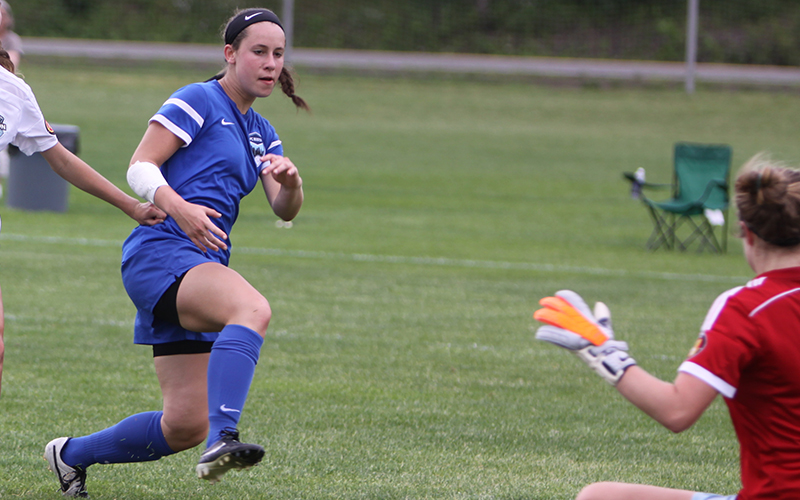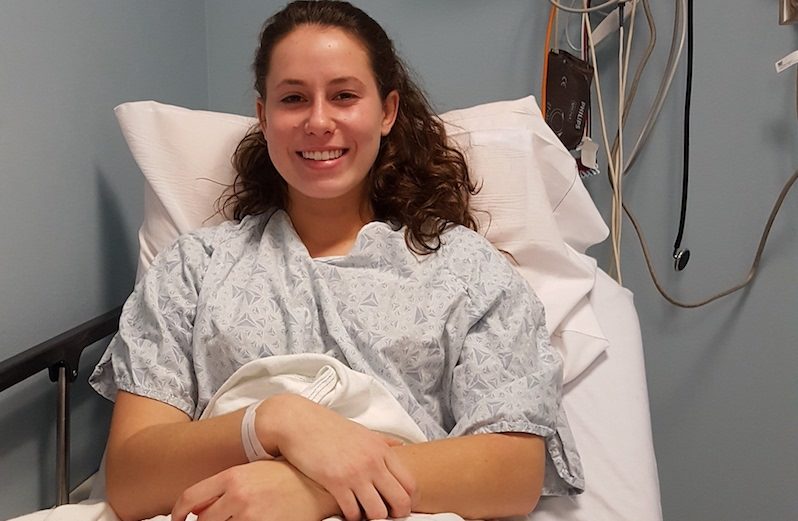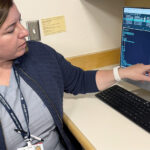A dream deferred but not denied by ACL tear

The dream of playing college soccer was within reach. Emily had been working on her game since she was four years old, and at 16 was now co-captain of both her high school and club teams. Colleges were taking note.
Just three games into club season, Emily was on the field in North Carolina, running back to her net when she tore her left anterior cruciate ligament (ACL). She heard her knee pop, and knew immediately what had happened. “I’ve always had a high tolerance for pain, but that definitely raised the bar,” she says. Her mother Lauri can still hear her daughter’s screams from that day as she watched the event unfold from the sidelines.
Six months later, Emily is tackling recovery the same way she tackles life. “Emily is a go-getter,” says Lauri. “In school and in soccer, she works and works and works — she just never stops.”
Double diagnosis: Torn ACL and meniscus
The day of the injury, Emily and her family bought a pair of crutches and some Advil at a local pharmacy, and flew back to Boston on their scheduled flight. Despite the pain, Emily went to school the next morning because she didn’t want to fall behind in her studies. Her dad picked her up early from school and they drove together to meet with Dr. Benton Heyworth, orthopedic surgeon at Boston Children’s Hospital Sports Medicine Division.
An MRI confirmed Emily had torn both her ACL and meniscus. She knew it was coming, but the diagnosis was hard to hear. “I remember looking out the window in his office and just crying. That was a tough moment.”
But in typical Emily fashion, she wiped off her tears and geared up for what was next. “Dr. Heyworth explained everything about how the surgery is done, what to expect during recovery, and how important physical therapy would be,” says Emily. “Dr. Heyworth is incredible,” adds Lauri. “He talks to both the patient and the parent, and answers all of our questions.”

On December 21, just 17 days after the injury, Heyworth performed reconstruction surgery on Emily’s knee — repairing the meniscus and replacing the ends of her torn ACL with a tendon graft from her own hamstring. “One of the many ways we invest in our patients’ long-term health is by focusing on joint preservation,” says Heyworth. “In Emily’s case, we repaired her torn meniscus instead of performing a partial meniscectomy, which involves trimming part of the meniscus out and can cause an accelerated rate of arthritis.”
Recovery: A focus on injury prevention
With ACL re-tear rates as high as 13 percent for teens, the right recovery program is key to a healthy and strong return to play. “Our ACL Program is unique in that everyone who undergoes ACL surgery at Boston Children’s has access to The Micheli Center for Sports Injury Prevention,” explains Heyworth. “Here, sophisticated injury prevention assessments are performed 6 months after the surgery, and again at 9 or 12 months, if necessary. The extra support is important and allows us to assess lingering or persistent issues before an athlete returns to play.”
Emily’s early recovery involved a full-leg brace and no physical activity. She admits those first few months were emotional as she longed to get back in the game and doubted her ability to do so. Frequent check-ins with Heyworth and The Micheli Center helped remind her she was on track. And two friends who tore their ACLs before Emily offered companionship and support. Their high school classmates refer to the three girls as “The ACL Crew.”
Prognosis: College soccer still in sight

Today, things are looking up. Emily wears a more flexible sports brace and can run on a treadmill. She maintains a rigorous schedule of daily physical therapy, as Heyworth had recommended. “Obviously I’d rather be at practice, but the only way to get better and play soccer again is to do what I know I need to do.”
Emily is likely to be back on the field by September, just in time to shine for college coaches. She is hopeful but patient. “It took me years to get the hang of skills like cone dribbling and shooting with both feet, but I never gave up. I learned that things take time and will always fall into place.”
Until then, Emily is exploring other interests. “I miss soccer, but now that I’m not playing, I’ve been able to focus more on my schoolwork and start a job. I believe that everything happens for a reason. You might not know why something happened to you, but if you’re willing to accept it, you’ll see things you would have never noticed before and you’ll be stronger in the end.”
Learn more about Boston Children’s Hospital ACL Program.
Related Posts :
-

3D imaging could become standard practice in orthopedics. Here’s how.
It took a trained eye to see the abnormality on the patient’s X-ray. There, hidden behind the acetabulum was ...
-

A safe, pain-specific anesthetic shows preclinical promise
All current local anesthetics block sensory signals — pain — but they also interrupt motor signals, which can be problematic. For example, ...
-

Adam takes a pause from his active life for non-ossifying fibroma
Adam was 11 in early 2024 when he and his bike slid under a downed tree. Such events aren’t unusual for ...
-

Ask a sports medicine specialist: Why are ACL tears so common among female athletes?
When an athlete is sprinting after an opponent who suddenly stops or changes direction, their anterior cruciate ligaments (ACLs) make ...





